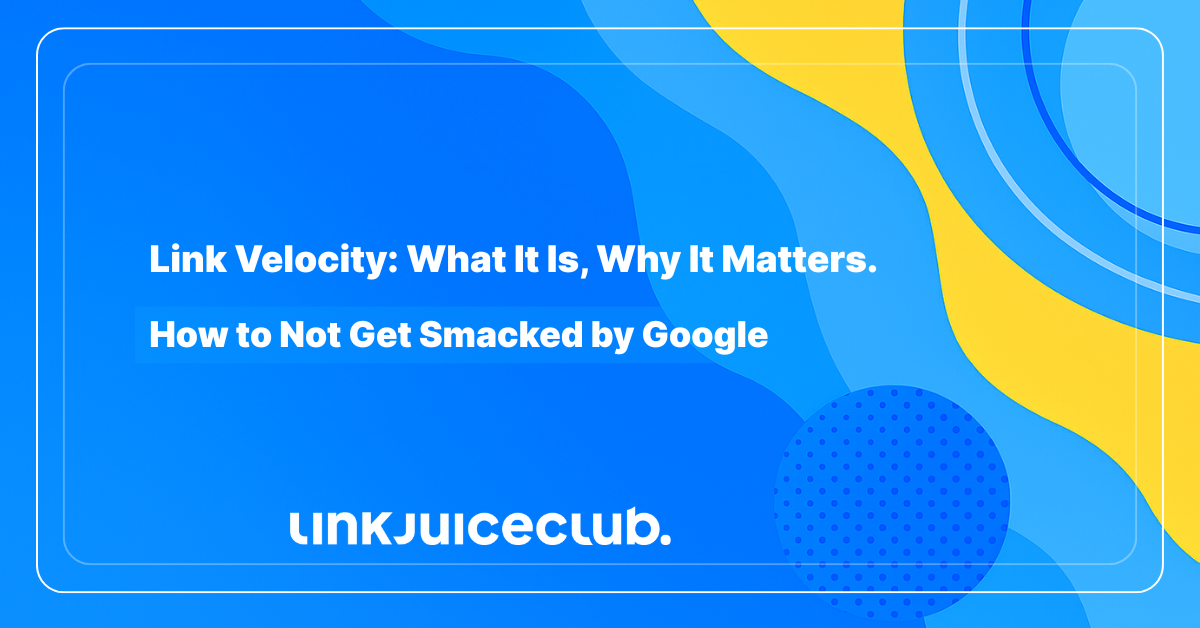
Link Velocity: What It Is, Why It Matters, and How to Not Get Smacked by Google
Link velocity is the rate at which your site gains (or loses) backlinks over time. And yes, Google’s watching.
Why? Because sudden spikes or shady-looking patterns don’t scream “popular brand.” They scream “link scheme.”
Let’s break it down.
Imagine Doobie & Co. (your friendly neighborhood pet brand) drops a fresh blog post on Monday — “Top 10 Pet Foods That Don’t Suck.” By Friday, it has 5,000 backlinks from expired coupon sites, abandoned directories, and shady forums in six languages.
🚨 You think that looks legit?
Neither does Google. That link profile lights up red like a Christmas tree in the spam filter.
That’s link velocity gone wrong.
Why Link Velocity Can Make or Break Your Rankings
Backlinks aren’t just about quantity, it’s the pace and pattern that tell Google what’s going on. That’s where link velocity comes in.
If your backlink graph looks like a smooth climb? Good. If it looks like a stock market crash or a lottery win? Not so much.

🚔 What Happens When You Trigger Google’s Tripwire
Google’s not guessing. It’s seen every trick in the book.
That’s why it created Penguin, the 2012 update that nuked link farms, spammy exchanges, and paid link schemes overnight. Sites trying to “buy their way up” got buried. Some never recovered.
Still sounds like a good idea to buy 500 backlinks and call it a day?
Here’s what not to do (yes, Doobie & Co., we’re looking at you again):
- 💸 Pay for backlinks labeled “high authority” (spoiler: they’re not)
- 🔗 Blast your site across 50 irrelevant blogs in a week
- 🤝 Link trade with unrelated local businesses to “boost rankings”
You might see a quick jump. But it’s a trap. That kind of spike? Google sees it, flags it, and acts fast. Your rankings won’t just stall, they’ll reverse.
Organic Growth vs. Obvious Link Fakery
Not all backlinks are created equal — and Google can tell which ones are earned vs. engineered.
🔍 The Two Types of Link Growth:
- Organic: Your content gets noticed, shared, and linked. Real humans, real intent.
- Artificial: You pay, trade, or mass-submit. The graph spikes, then drops.
Let’s go back to our friends at Doobie & Co.
If their pet food guide gets picked up by a popular vet on TikTok and linked by legit bloggers over a month? Organic, solid, sustainable.
If they flood Fiverr with link orders and wake up with 500 new backlinks from weird domains? Artificial, fragile, and obvious.
Google ignores the junk, or punishes it. Either way, you lose.
Link Velocity as a Trust Signal (or a Warning Flag)
Want domain authority that sticks? It starts with consistency.
Search engines don’t just crawl your links. They analyze your link velocity profile to spot red flags:
- 📈 Steady, relevant growth = trusted site with valuable content
- 🚀 Sudden link burst from junk domains = manipulation attempt
- 📉 Link drop-off = aging content, negative SEO, or neglect
Example: If Doobie & Co. keeps landing links from trusted pet blogs, niche media, and vet associations? That builds authority. If they suddenly pick up 1,000 links from crypto forums and random coupon sites? That’s a problem.
Google doesn’t care how many backlinks you have. It cares how you got them.
Good vs. Bad Link Velocity: How to Spot the Difference
Not all link growth is created equal. Some signals tell Google, “Hey, this site’s legit.” Others scream, “I bought this on a forum for $27.”
Here’s how to tell what’s helping… and what’s asking for a penalty.
✅ What Good Link Velocity Looks Like
This is what healthy, high-trust link growth actually feels like under the hood:
- Steady climb: You’re earning links consistently, a few per week, maybe more if you publish often.
- Domain diversity: You’re not just racking up 40 links from the same blog roll. You’re showing up across unique sites, directories, podcasts, mentions.
- Topical alignment: Pet blog? Get pet links. A backlink from PetMD makes sense. One from a crypto roulette site? That’s SEO malpractice.
The best part? When this is happening, you probably don’t even notice. You’re doing real marketing and the links just follow.
🚫 What Bad Link Velocity Looks Like
This is where link growth goes sideways:
- Explosive spikes: You go from 12 backlinks to 400 in 48 hours, with zero press, virality, or new content to justify it. Google’s not dumb.
- Junk sources: If your backlinks come from auto-spun blogs, expired coupon domains, or PBNs with lorem ipsum on the homepage… expect trouble.
- Anchor spam: If 87% of your links use “best pet food for 2025” as anchor text? You just gave the algorithm a clear footprint to flag.
🐾 Doobie & Co. vs. The Shortcut Crew
Let’s break it down:
- Doobie & Co. plays it smart. They build links via legit PR, guest posts, and influencer mentions. Their growth is slow and clean.
- Their competitor buys 500 links from some shady service. Velocity skyrockets in two weeks, then drops like a rock.
Six months later?
- Doobie & Co. ranks for 20+ keywords and gets steady organic traffic.
- The competitor? Nowhere. Penalized, deindexed, gone.
Moral of the story? You don’t need hundreds of links overnight. You need the right links over time. And link velocity is how Google tells the difference.
How to Track Link Velocity (Without Drowning in Data or Missing the Red Flags)
You don’t need a PhD in SEO to measure link velocity, just the right tools, the right tabs, and the right metrics.
Start with the platforms that already do the heavy lifting:
- Semrush gives you a full timeline of link wins and losses, updated daily. It also shows long-term domain growth and alerts you to sudden spikes.
- Ahrefs breaks your backlink history into clean, detailed graphs with trendlines that let you zoom in or out on velocity.
- Majestic uses its “Fresh Index” and “Historic Index” to give you a window into both short-term and long-term backlink acquisition patterns.
- Google Search Console (GSC) doesn’t do charts, but it gives you the raw backlink data straight from Google, who’s linking to you, what pages they hit, and what anchor text they’re using.
Let’s focus on how to use Semrush and GSC to gauge your link velocity in a way that actually means something.
🔧 Using Semrush to Measure Link Velocity
Step-by-step:
- Open the SEO menu
- Head to Backlink Analytics under Link Building
- Plug in your domain
- Click the Referring Domains tab
- Now check the graph for new vs. lost domains over time
This is where you see how many domains are linking to you per day, per week, or per month, and how many you’re losing. Watch for plateaus, surges, or steady growth. They all tell a story about your authority profile.
A healthy link velocity here usually shows gradual, continuous acquisition, not random peaks or deep drops. If the chart looks like a stock you wouldn’t invest in, it’s probably bad SEO.
🧪 Measuring Link Trends in Google Search Console (GSC)
It’s not fancy, but it’s reliable.
Here’s how:
- Go to Google Search Console
- Choose your property (site) from the sidebar
- Scroll and click on Links
- Review the built-in reports:
- Top linked pages
- Top linking domains
- Anchor text usage
- Top linked pages
This helps you figure out which pages are attracting backlinks, who’s sending them, and what text they’re using to do it. No visualizations here, but it’s clean and direct. Think of this as your backlink health check, straight from the source.
The Metrics That Actually Matter for Link Velocity
You’ve got the tools, now it’s time to spot what’s working, or not. Pull the reports above and focus on the 5 velocity signals that actually impact rankings.
1. 📉 Referring Domains Over Time
This shows how many unique websites are linking to yours, not just total links, but who they’re coming from.
Look for:
- Steady growth over months
- Minimal loss or churn
- No sudden influx from irrelevant sources
If your backlink profile goes from 12 to 600 referring domains in two weeks, that’s not velocity, that’s a spam signal.
2. 🧷 Link Type Distribution
Not all links are created equal. Google knows the difference between a comment link on a junk blog and a contextual link from a real publisher.
In Semrush, you can check this by:
- Going to SEO → Link Building → Backlink Analytics
- Entering your domain
- Scrolling to Backlink Types and Link Attributes
A natural-looking backlink profile should include:
- A healthy mix of DoFollow and NoFollow links
- Mostly text links, with a few image-based or form-based links mixed in
If 100% of your links are DoFollow? That’s a little too perfect. It can set off alarms for link buying or manipulation.
3. 🧵 Anchor Text Variation
Anchor text is the text that makes a link clickable, and it’s one of the most misunderstood SEO factors.
Too much repetition of keyword-rich anchors like “best pet food blog” across all your links? That looks like it was written by a bot.
In Semrush:
- Head to Backlink Analytics → Anchors
- Review the variety and volume of different anchor phrases
What you want to see:
- Branded anchors like “Doobie & Co.” or “doobieandco.com”
- Partial matches like “pet nutrition blog” or “guide to feeding pets”
- Generic phrases like “this article,” “read more,” or “click here”
When anchor usage is balanced, it signals natural linking. When it’s uniform and keyword-heavy, it screams manipulation.
4. 🔄 New vs. Lost Backlinks
Velocity isn’t just about what you gain, it’s also about what you keep.
Losing backlinks at the same rate you gain them? That’s not progress. That’s treading water.
To check this in Semrush:
- Go to SEO → Link Building → Backlink Analytics
- Plug in your domain
- Click on the Backlinks tab
The graph here shows new and lost links over time. If your profile’s a rollercoaster, that’s unstable territory. A trustworthy site builds slowly and sheds links infrequently.
5. 📊 Long-Term Growth Trends
Zoom out. Patterns beat snapshots.
Check your backlink trendlines in Semrush or Ahrefs over 3–6 months. You want to see:
- Gradual, upward momentum
- Domain diversity rising alongside total links
- No sharp vertical jumps without a clear cause (like PR or viral content)
If the curve looks smooth and predictable? That’s link velocity working in your favor. If it’s jagged, volatile, or stagnant, you’ve got an SEO leak.
Bottom line: Link velocity isn’t about how many backlinks you get — it’s about how they grow, where they come from, and whether the pattern looks like the internet actually cares about your site. Track that, and the rankings will follow.
Link Velocity Red Flags: What Can Go Wrong (and How Google Spots It)
The moment you start monitoring your link growth patterns, you’ll realize: not all velocity is good velocity. Some backlink spikes signal trust. Others trip every filter in Google’s spam detection system.
If your graph suddenly looks unnatural, algorithm alarms go off. That’s where penalties, link devaluation, or ranking drops come in.

Here’s how to spot the red flags early, before your SEO takes a hit.
🚨 Sudden Link Surges Trigger Spam Filters
Let’s say Doobie & Co., your favorite fictional pet brand, typically earns 5–10 new referring domains a month — the slow, steady climb. A niche blog here, a directory there. But out of nowhere, 200 new links pop up in 48 hours.
What just happened?
To Google, that pattern looks manufactured. And in many cases — it is.
Here’s the deal: Google’s spam detection system isn’t only looking at quantity. It’s analyzing timing, link type, anchor usage, and site relevance. So when backlinks suddenly skyrocket without new traffic, content, or PR to explain it, it gets flagged.
Even a one-time spike isn’t always harmless. If your site has shallow pages, keyword-stuffed anchor text, and no real user engagement, that unnatural growth gets treated like a red flag.
Here’s what that might trigger:
- Devaluation of all new links
- Suppressed rankings for the affected page(s)
- Manual action if Google decides it’s part of a pattern
Organic link growth should mimic brand momentum. Sudden link explosions without public-facing momentum look suspicious — and often, they are.
📉 When Link Velocity Drops, Google Sees Decline
On the flip side, plummeting link velocity can also be a sign of trouble.
Say Doobie & Co. starts bleeding backlinks, not just a few. Imagine dropping from 1,000 referring domains to 650 in a single day. That’s not business as usual. That’s a warning flare.
Why does this matter?
Because backlinks aren’t just a number, they’re a trust signal. When high-authority domains stop pointing at your site, Google assumes there’s a reason: outdated content, broken pages, loss of relevance, or worse, link removals due to policy violations.
What causes backlink losses?
- Old media coverage gets pulled
- Blog posts with your link get deleted or redirected
- Broken URLs on your end (hello, 404s)
- CMS migrations without proper 301s
- Manual cleanup by webmasters or site owners
Sure, some link decay is natural. No one’s immune. But here’s when you know it’s a problem:
- You can’t pinpoint why links disappeared
- You’re not actively reclaiming them or replacing them
- Your authority relied on just a handful of high-powered links
Losing 20 backlinks over a few months? Fine. Losing hundreds overnight with no mitigation plan? That’s how rankings collapse without warning.
🛠 How to Catch Link Decay (Before It Torpedoes Your Rankings)
If you’re not running backlink audits regularly, you won’t see the warning signs until it’s too late.
Here’s how to fix that:
Use tools like:
- Semrush → Backlink Audit Tool
- Ahrefs → Lost Backlinks tab
- Moz → Link Explorer
Let’s walk through Semrush:
- Go to the SEO tab
- Click on Link Building
- Select Backlink Audit
- Enter your domain and let it crawl
The audit will give you:
- A full list of lost links
- Breakdown of domains and pages removed
- Probable causes (e.g., broken links, removed content, or lost authority)
This isn’t just data, it’s your action plan. You’ll know which links you can try to recover, which ones aren’t worth it, and how to rebalance your profile before Google reacts.
📋 Link Velocity Red Flags: What to Watch Closely
These are the most common signals Google associates with manipulated link velocity. If your reports show one (or worse — several), it’s time to audit fast.
| RED FLAG | WHAT IT MIGHT MEAN |
| Sudden 10x increase in referring domains | Suspicious spike, likely artificial or spam-related |
| Surge in links from low-authority sources | Low-quality PR, PBNs, or automated linking tools |
| Overuse of exact-match anchor text | Keyword stuffing, unnatural optimization |
| Declining number of referring domains | Lost trust, aging content, link decay |
| Links from irrelevant industries or topics | Niche mismatch, risky or accidental link swaps |
| Links coming in faster than new content is added | Unnatural velocity, potential link scheme in progress |
💡Velocity Is a Pattern, Not a Number
The truth is, link velocity isn’t about volume. It’s about context, timing, and intent.
Backlinks earned at the right pace, from the right places, with the right diversity = long-term authority. But if the pattern shifts too fast, too hard, or too obviously, you won’t climb. You’ll collapse.
Google doesn’t just count links. It watches how they grow, where they come from, and whether they tell a believable story about your site.
If that story feels fake, your rankings won’t just freeze, they’ll fade.
What Triggers Unnatural Link Velocity (and How to Catch It Before Google Does)
If your backlink profile suddenly spikes, and you can’t explain why, odds are, something’s wrong. Because link velocity doesn’t just accelerate on its own. It’s usually the byproduct of short-sighted strategies, mass-scale outreach, or outright manipulation.
Here’s what causes most velocity problems, and how to avoid setting off Google’s red flags.
🧨 Viral PR That Misses the Mark
Going viral feels like a win… until it tanks your niche authority.
Let’s say Doobie & Co. lands a mention in a roundup titled “Top Quirky eCommerce Brands.” The story spreads, and suddenly they earn 150 backlinks in 7 days. Sounds great, right?
Except, 90% of the links are from humor blogs, meme accounts, and aggregator sites with zero relevance to pets or eCommerce.
Now instead of reinforcing your topical authority, those backlinks confuse Google. You’re no longer “the trusted pet store”, you’re “the random brand that ended up on a meme blog.”
Even worse? If this happens repeatedly, Google starts associating your site with unrelated topics, which can dilute rankings for the right keywords.
Lesson: Viral velocity without vertical alignment is a trap. Relevance beats reach.
🔗 Link Builders Who Promise the Moon (and Deliver a Mess)
If someone promises you 5,000 backlinks in 30 days, run.
This is how most velocity disasters start: you outsource SEO to a “white-hat” agency or marketplace that guarantees high-volume links. But where do those links actually come from?
Here’s what’s behind the curtain:
- PBNs (Private Blog Networks) full of recycled domains and duplicate content
- Link farms that trade backlinks like Pokémon cards
- Guest post schemes where every article looks like it came from the same template factory
For example, if a provider offers “Guaranteed 9,000 high-DA backlinks,” that’s a flaming red flag. Real authority isn’t guaranteed. And mass link guarantees almost always mean spam.
Pro tip: If you can’t inspect the source, vet the domains, or control the anchor text? Don’t buy it.
🧼 Negative SEO: When Your Competitors Try to Wreck You
Sometimes, unnatural link velocity isn’t your fault. It’s an attack.
Negative SEO is when a competitor intentionally bombards your site with toxic backlinks, hoping to trigger a penalty. They might use bots, spam scripts, or shady tools to blast your domain with thousands of links from sketchy industries like:
- Pharma
- Gambling
- Adult
- Fake tech blogs with AI-generated junk
Imagine Doobie & Co. notices 1,000 new backlinks from casino and pill review sites, overnight. That’s not outreach. That’s sabotage.
Now, the good news: Google is usually smart enough to ignore obvious spam. But if the pattern mimics a real link scheme, or if your existing backlink profile is already shaky, you could get hit.
Here’s what to do if you suspect an attack:
- Open GSC and check new referring domains regularly
- Document every spammy domain and unusual surge
- Disavow only if links are clearly toxic, consistent, and provably hurting rankings
Important: Don’t overuse the disavow tool. Only fire that shot if you know it’s needed, and be ready to explain it in a manual review.
⚠️ Shortcut Link Growth = Long-Term Penalty Risk
Whether it’s a viral fluke, a lazy agency, or a jealous competitor, unnatural link velocity always leaves a footprint. Google doesn’t just look at your link count, it looks at how fast, from where, and why now.
If the answer doesn’t make sense? That’s when penalties land and rankings vanish.
Keep your velocity clean, relevant, and intentional. The backlinks will stick, and so will your authority.
How to Build Healthy Link Velocity (That Actually Helps You Rank)
You want links that stick? You need velocity that looks natural, steady, relevant, and rooted in value. That means no spikes, no fluff, and no shortcuts.
Let’s break down the real way to build a backlink growth curve that Google likes.
📚 Start with Link-Worthy Content (No, Really)
Yes, everyone says “create great content.” But here’s the punchline: 90% of the internet isn’t worth linking to. If your content adds no original value, no one’s going to reference it, and your link profile will flatline.
So what actually attracts natural backlinks?
- Original data: Survey results, industry stats, benchmarking studies
- Evergreen guides: Deep, timeless resources that become go-to bookmarks
- Tool tutorials: Walkthroughs of complex platforms your niche uses daily
Pro test: If your page disappeared today, would anyone even notice? If the answer is no, don’t expect links, expect silence.
Want link velocity that builds itself? Make content that deserves to be cited — not buried.
📰 Build Authority with Smart, Niche PR (Not Just Press Releases)
You don’t need a front-page feature in Forbes. You need credibility, and consistency, in the right circles.
PR is about visibility in the places your audience already trusts. You’re not fishing for traffic, you’re planting trust signals that earn links over time.
Tactics that drive healthy link velocity:
- Topical press releases tied to product updates, events, or data
- Reactive PR using HARO, Featured, or “Help a B2B Writer” to insert commentary into breaking stories
- Quote placement in expert interviews or contributor roundups
- Podcast features where your founder or team shows up with actual insights
The goal here isn’t vanity, it’s validation. These links show up in the right niches, build relevance, and create the kind of velocity that algorithms reward, not penalize.
🧠 Contribute to Other People’s Content (and Become a Go-To Voice)
Don’t just wait for links, earn them by becoming a cited source.
Here’s how to do it without pitching guest posts all day:
- Find roundup opportunities (e.g., “15 experts share favorite link building tactics”)
- Use platforms like Qwoted, Featured, and Terkel to insert your insights into live journalist queries
- Offer custom quotes in Slack groups, niche newsletters, or micro-community requests
This builds two things at once:
- Referring domains — clean, organic link growth
- Industry presence — you’re now the person people quote
Pro tip: Focus on relevance over domain rating. A contextual backlink from a DR50 blog in your niche beats a random DR90 travel site link any day.
🔗 Use Internal Link Velocity to Support External Gains
Want to boost your rankings without begging for backlinks? Master your internal linking game.
Internal link velocity = how quickly and consistently you build inter-page links as your site grows. It’s the secret weapon most SEOs ignore, but it plays a huge role in:
- Distributing link equity (especially from pages already ranking)
- Signaling topical relationships across clusters
- Improving crawl depth and indexation rate
Here’s the playbook:
- Every new post links out to 2–5 related evergreen pages
- Older high-authority posts get updated to link into the new content
- Use anchor text that reflects search intent, not exact match spam
Example: Instead of linking with “SEO tools,” use anchors like “tools we rely on for outreach” or “internal systems for link audits.” Natural, contextual, useful.
Bonus: This improves your real user experience too, and that makes your external backlinks even more effective.
Use AI to Accelerate — Not Automate — Your Link Velocity
AI tools have completely reshaped how fast we can create, iterate, and scale content. But here’s the catch: more content doesn’t mean better backlinks.
The winning approach? Augmentation over automation.

That means using AI like a research partner — not a ghostwriter. The content still needs your insights, experience, and POV. AI just helps you move faster, not disappear from the process.
What does that look like in practice?
- Use AI to outline topic clusters, then layer in your perspective and expertise
- Let tools like Clearscope or Surfer surface link opportunities and related queries
- Tweak AI drafts with your tone, examples, and real data before you hit publish
Why does this matter?
Because people link to value — not volume. If your AI-generated post reads like a content mill copy/paste job, no one’s citing it. No one’s sharing it. And Google knows it.
⏩ Faster Link Velocity Is Fine (If You’ve Earned the Trust First)
If you’re building a brand-new site, slow down. Aggressive backlink surges for new domains scream link scheme. But if your domain has history, reputation, and visibility? You can ramp up faster, without triggering spam filters.
Here’s why aged domains can handle velocity growth:
- They’ve built backlink patterns Google already trusts
- Their niche and intent are clear across thousands of signals
- As links increase, so do brand searches, social mentions, and direct traffic, the velocity matches visibility
In short: older sites have earned the right to grow faster.
But even then, don’t get cocky. If you start stacking sketchy links from PBNs, AI-spun guest posts, or mass directories, it’s just a matter of time before it crashes.
The truth? SEO doesn’t punish speed, it punishes fakery.
🏗 Build a Link Velocity Curve That Lasts
If your backlink graph looks like a heart monitor, that’s not a strategy, that’s a liability.
Want real rankings that hold steady through every algorithm update?
Then build velocity the right way:
- Publish often — but prioritize quality over calendar quotas
- Push content across email, Slack groups, social, and newsletters
- Show up in niche communities, podcasts, and curated lists
- Give people a reason to link — solve a problem or drop original insights
Velocity isn’t a sprint. It’s a rhythm. The more consistent, useful, and relevant your content becomes, the more naturally your links stack.
⚙️ Pro Tip: Track the Signals Before They Turn to Problems
Use tools like Semrush or Google Search Console to monitor your backlink profile. Not just to count links, but to:
- Spot weird spikes before they look artificial
- Track new vs. lost domains
- Audit anchor variation and source diversity
Keep the velocity curve steady. Spot the cliffs early. And when in doubt, trim the junk before Google does it for you.
Want help understanding all the backlink types in your audit report? Our full guide breaks them down, with examples and tips on how to earn the ones that actually move rankings.





